Trains are better for the environment than cars or planes. High-speed trains can be quicker too. I spoke to William Sugrue, an engineer at the European Investment Bank, to find out how high-speed trains work and how they’ ll look in the future
By Antonella Santi and William Sugrue
What’s the difference between normal trains and high-speed trains? Is it just a matter of speed?
A high-speed train can be compared to a sports car on a motorway: it is not just the type of vehicle that matters. To be fast you also need special infrastructure. The curves of the track have to be as shallow as possible – no sharp bends, and on tracks where trains go at high-speed level crossings are not allowed.
The vehicles are also different from normal regional trains. They have to reach speeds of 300km/h or faster and so they need powerful engines and also powerful brakes. Passengers are not expected to stand because of the long journey time and therefore there are no dedicated standing places and no handholds. There are also fewer doors on a high-speed train than on a regional train. Regional trains stop every few minutes, so to reduce the time people need get on and off there are more doors. Reducing the time stopped in the station by one minute for a regional train can save up to 12 minutes of journey time each hour. A high-speed train only stops one or twice in an hour, so the time savings would not be significant.
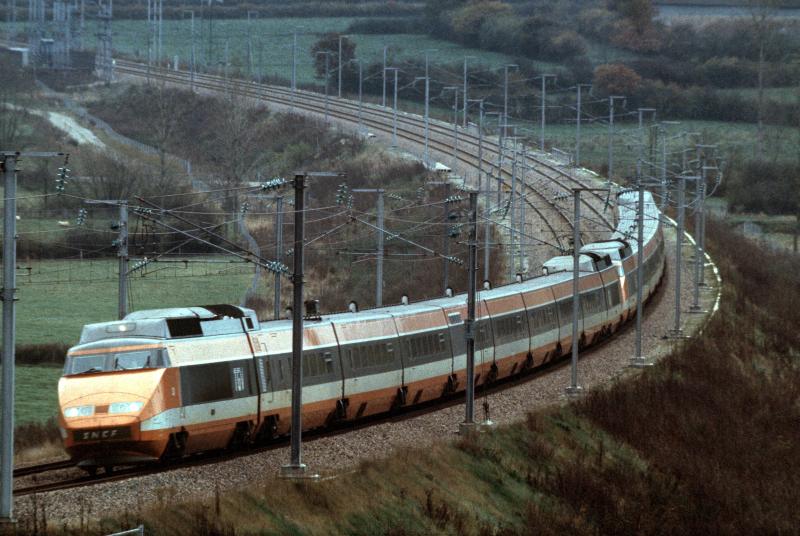
TGV (Train grande vitesse), 1981
When did the first high-speed train enter into service and where?
The first time high-speed trains ran on a line specifically built for high-speed running, was in Japan in 1964. It was the Tōkaidō Shinkansen line, connecting the cities of Tokyo and Osaka. Trains on this line were able to travel at 210 km/h, at a time when most countries still had steam trains and the fastest train in commercial service only ran at 160 km/h. The Shinkansen trains are also known as “bullet trains,” because the first models had a rounded nose and looked a bit like a bullet. In Europe, high-speed trains made their debut in France almost 20 years later in 1981. The first French TGV (Train grande vitesse) connected Paris and Lyon.
Why and where are high-speed trains needed?
Looking at journey times, if it takes less than four hours city centre to city centre, high-speed trains are a very attractive option for travellers and can capture up to 50% of the rail-air market share. When we come to the operating point of view and we consider environmental eco-friendliness, we should remember that high-speed lines are generally built where there is a high demand. If the existing lines are not able to have more intercity, commuter, or freight services, then the other option is to transport passengers or goods by road. If we look at the impact of trucks compared to trains, there is far less energy used to move a ton of freight by train than there is in moving it by truck.
The amount of energy needed to fly from Luxembourg to Paris is 829 MJ, the equivalent of 29 litres of petrol per person. By car you would need 629 MJ, that is 20 litres of petrol, while a trip by train would require 84 MJ. In terms of carbon dioxide emissions, a plane would produce 72 kg of CO2 per passenger, a car 55 kg and a train only 3 kg, because it relies on electric power.
Are they environmentally friendly?
People do worry when a new line is announced or being constructed. However, today infrastructure projects have to follow strict environmental requirements. They cannot build during nesting season or during the hibernation period. They may have to wait or resettle the species living in that area before they can start with construction work. In addition, wildlife crossings or grass bridges are built to let animals pass, if the line goes through a forest or a wood. As for pollution, high-speed trains are powered by electricity from an overhead line.
Quite often high-speed trains end up going through tunnels, because usually they can’t climb steep gradients. Tunnels have a much lower impact on water courses, animals, the woodlands or forests.
The capacity of a railway line is different from capacity on a road. On a road, if the car in front is travelling too slowly, you can overtake it. On railways this isn’t really possible, most of the time. A railway line has a certain number of “train paths” per hour, like an airport, which only has a certain number of landing or take-off slots per hour. However, mixing trains of different speed on the same railway reduces the total number of trains that can use the line per hour compared to the number if they were all travelling at the same speed. By separating trains of different speeds, a new high-speed line allows an increase in capacity for the high-speed trains, but also for the slower regional, commuter or freight trains using the existing tracks.
If we think of energy, for example, the amount needed to fly from Luxembourg to Paris is 829 megajoules (MJ), the equivalent of 29 litres of petrol per person. To travel by car, you would need 629 MJ, the equivalent of 20 litres of petrol, while a trip by train would just require 84 MJ. If we look at that in terms of carbon dioxide emissions for the same journey, a plane would produce 72 kg of CO2 per passenger, a car 55 kg and a train only 3 kg, because it relies on electric power. It is a large difference in environmental impact.
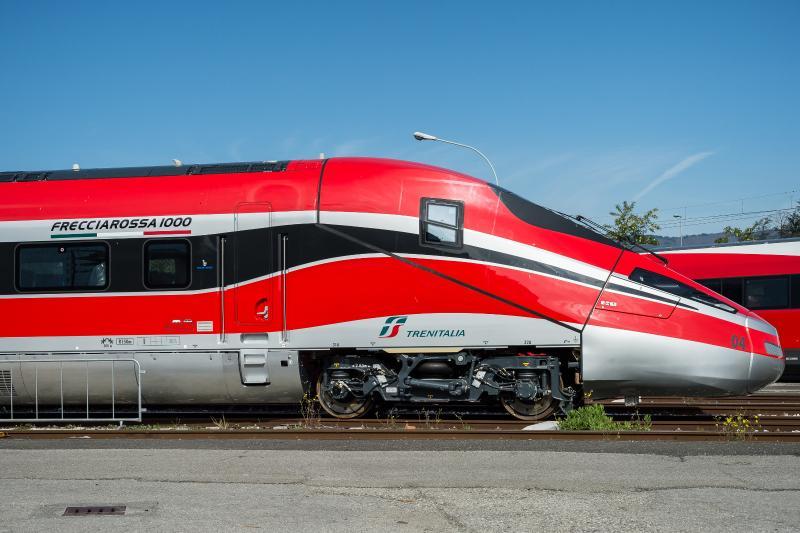
Frecciarossa 1000
Why is the construction of a high-speed rail so expensive?
A high-speed line is normally a new line. Costs can vary, depending on the countries and the cost of construction, and on the topography (the hillier the landscape the more need for bridges and tunnels). High-speed lines can vary in price from €8 million to €50 million per kilometre. That sounds a lot, but motorways vary from €6 million to €30 million per kilometre. If we want connectivity between big cities or across long distances, what are the options? The infrastructure cannot zigzag around hilly, rivers and man-made structures, so this means more bridges and more tunnels to get around, under or over these obstacles. High-speed rail project often require large amounts of financing. It is the role of international financial institutions such as the EIB to support the development of these kind of projects to provide high performing, sustainable and efficiently interconnected trans-European networks
What is the technology of high-speed rail? What are the technologies behind it?
One of the big differences in the technology is signalling. On normal trains you have signals the driver can see when looking out the front of the train. With high-speed trains the signals are inside the cab where the driver sits. Does the train need to brake, or to accelerate? Does it need to stop immediately? This is communicated directly from the signal box to the train cab, otherwise by the time the driver sees the signal at 300km/h it would be too late. There are many types of these “in cab signalling”, which makes it difficult for a train to cross international borders as it has to be able to interact with all these systems. In order to solve this problem of “interoperability” and create a “European Single Rail Area”, the European Union is supporting the deployment of a new signalling system called the European Train Control System (ETCS). The newer high-speed lines and some existing high-speed lines have been fitted out with ETCS, this will over the medium term allow trains to cross borders with less difficulty, especially with regards to signalling.
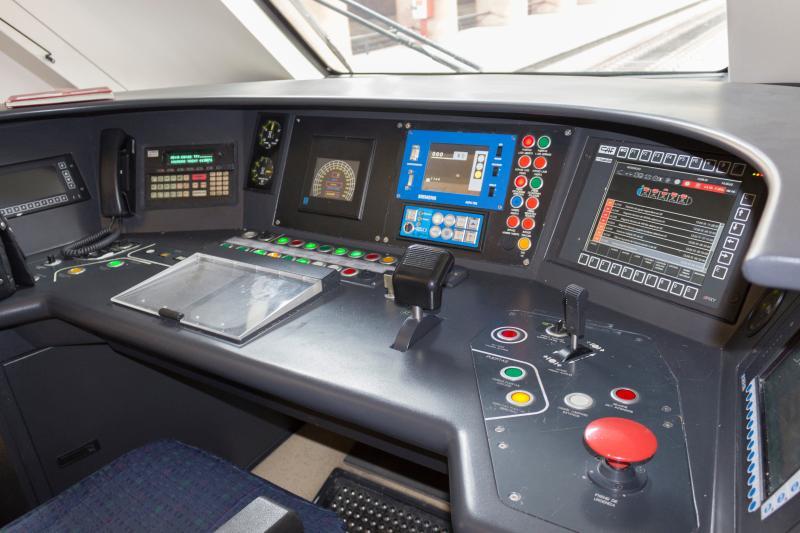
Dashboard of a Spanish high-speed locomotive
If you look at the wheels, you can see that high-speed trains, like every other sort of trains, have slightly conical wheels. This stops the train falling off the rails. The surface touching the top of the rail is smooth, but a flange (a raised edge) in the inner part of the wheel which acts as a last resort to stop the wheels coming off the track. The flat part of the wheel has a smaller diameter on the outside, which makes the train automatically stay on the track without the flange having to touch the rail.
When the train goes round the corner, at speed, the track is slightly lifted into the corner. If you are turning left, the right hand side of the track is lifted up and the left hand side is pushed down. It is like a motorcyclist leaning into the curve. So your coffee on the table doesn’t go flying across the table, because you are forced to the outside of the train while you are travelling at 300 km/h.
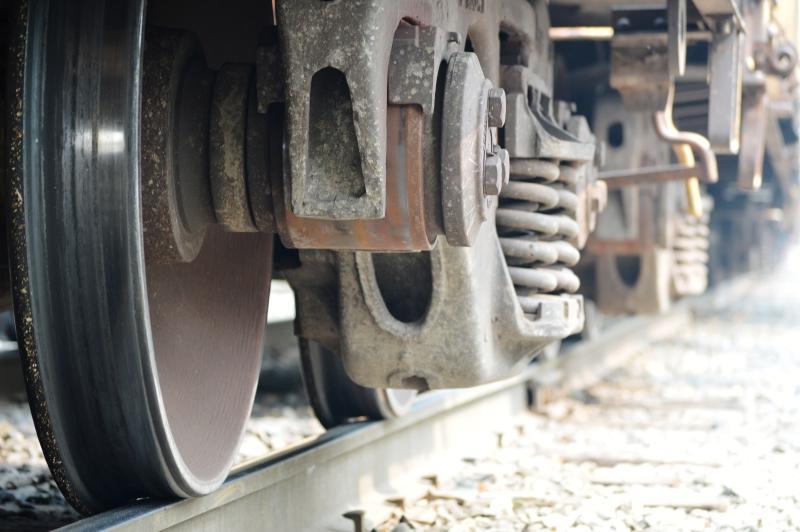
Detail of a conic wheel
Why can't high-speed trains use current tracks? Are there any standards?
When the Japanese authorities decided to build a high-speed line, the existing track gauge (the distance between the inner faces of the rail) of their railway system—equal to 1,067 millimetres—was too narrow to carry larger trains, which could carry more people. So they created specific high-speed lines with a track gauge of 1,435mm (which is the same gauge as in most European countries). This is called “standard gauge”. In many European countries high-speed trains can travel on the existing lines, which are used also to serve cities not directly on the high-speed line. But when high-speed trains use these lines, they cannot go at full speed.
In Spain, for example, high-speed trains also use the 1,435mm gauge, but this is narrower than the conventional Spanish network. However, some trains can change their gauge as they go along. Once they come to the end of the high-speed line, the whole train expands its wheels so that they fit onto the existing railway network and continue at the same speed as the regional trains.
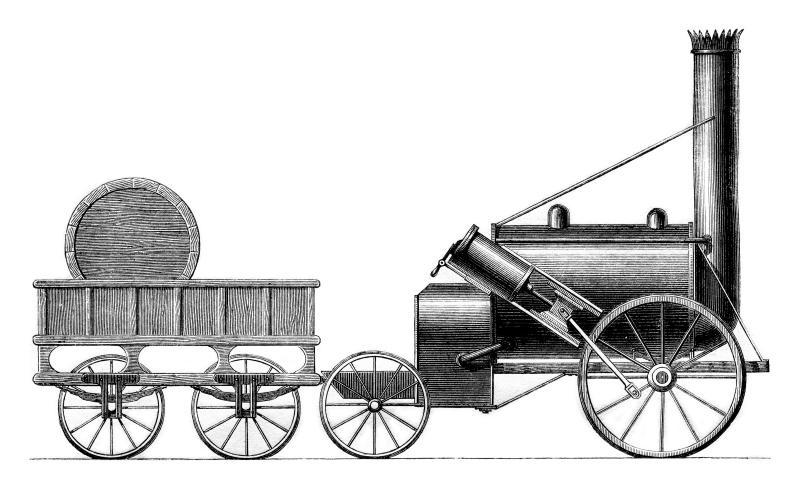
George Stephenson’s Rocket, an early steam locomotive
The 1,435 mm gauge also has an historical background. The British engineer George Stephenson used it for the Liverpool and Manchester Railway (the first locomotive-only railway in the world, with no horses pulling carts). With the success of the project, this gauge was applied to several other railway lines.
In most of Europe, trains run on the right, but some countries like the UK, Ireland, Portugal, Belgium, Sweden, Italy, Slovenia and France (except Alsace-Moselle) drive on the left.
Not all high-speed trains use the same voltage. High-speed-trains usually run on 25,000 volts alternating current (AC), but a few countries operate trains above 200km/h with other voltages, such as 15,000 volts AC in Germany, Austria and Switzerland. Some sections of high-speed lines in Italy and Russia use 3,000 volts AC. These other voltages are due to historical reasons.
However, technical specifications for interoperability have been adopted across Europe, which will standardise railway technology, so that in the future trains will be able to cross borders much more easily. At some point, one train will be able to cross the whole of Europe with no big problems.
What is the maximum speed that high-speed trains can reach? How safe are they ?
There is not a standard maximum speed. It depends on the type of train and the type of infrastructure. Like roads, different sections of railway lines have different speed limits. Some trains can reach 300 km/h, some 250 km/h. It depends on the infrastructure. Newer lines in France allow operations at 320 km/h, and in China there are trains that travel at 350 km/h from Beijing to Shanghai.
There are many checks and computer controls on high-speed lines and in high-speed trains. The in-cab signalling takes control of the train, which reduces the risk of human error. The major points of accident on railways are actually level crossings, but on high-speed lines they are not allowed. Existing ones have to be removed, if the speed of an existing line is increased to above 160 km/h.

The Shinkansen
Are there different types of high-speed trains?
There are single and double decker high-speed trains. Double decker trains are frequent where there is a very high demand, such as between Paris and Lyon, for example. In Europe, high-speed lines are designed specifically for this kind of train—the tunnels are big enough, the bridges are sufficiently high to fit them.
There are locomotive-hauled and multiple unit trains.
A locomotive hauled train, whether hauled by a steam, diesel or electric locomotive, has an engine on the front of the train pulling all the carriages. Carriages are not motorised, but they do have brakes. Acceleration is concentrated on the six, eight or twelve wheels of the locomotive. A multiple-unit train is similar to a tram or a metro train. Each carriage has a motor in it. Maybe not all the wheels are powered, but every second or every third wheel is powered by a motor.
With a locomotive-hauled high-speed train train, like the French TGV or Spanish Talgo, if there is a problem with the locomotive, it can be unhooked and another one can be re-attached. With a multiple unit train, like the latest versions of the German ICE (InterCity Express) or the AGV (Automotrice Grande Vitesse) in Italy, the space needed for the locomotive can be used to add space for passengers and increase capacity. Multiple units can accelerate quicker than a locomotive hauled train, but if there is a problem with one part of the train, the whole train must be taken out of service and the carriage must be repaired in a depot.
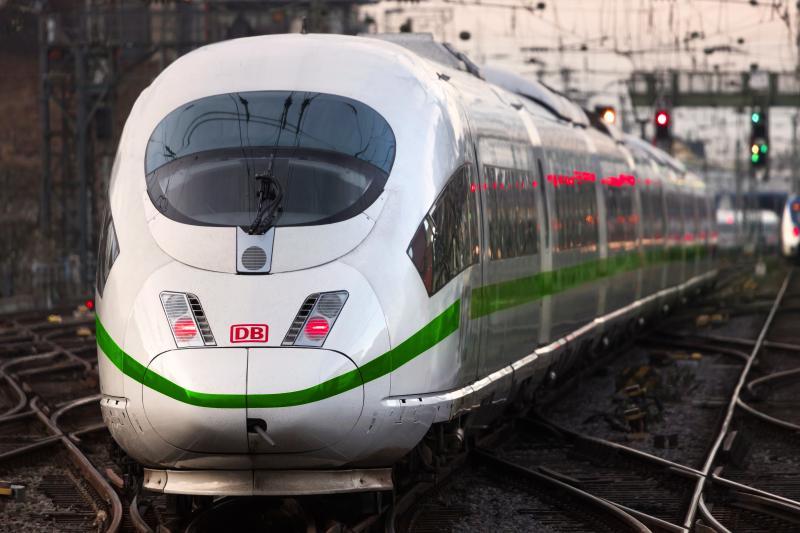
The green stripe on some German ICEs (InterCity Express) stands for “green project”
What’s the future of high-speed trains?
The future is going towards faster and higher capacity trains. China is now running trains for paying passengers on a daily basis at 350 km/h between Shanghai and Beijing, covering a distance of about 1,300 km in just over four hours.
There has recently been a development also in low cost high-speed services. They have no frills and only one class, but the trains are the same. It’s the same model adopted by low-cost fights. Stations served may not even be in the city centre. When you run on a train track in Europe, you are charged per kilometre and much depends on the train you are travelling on, how fast you are going, how heavy you are and also what sort of track you are using, if it is a regional line or a high-speed line. By stopping at stations out of town the train operator pays less.
Investing in high-speed rail in Europe will support a low carbon and competitive transport mode which connects major cities across Europe.
Antonella Santi is an editor at the European Investment Bank. William Sugrue is a railway engineer at the Bank.
